The cimaruta is a very old charm rooted in the lore of the Old Religion of Italy. Like many of the lasting ancient symbols and beliefs the cimaruta design eventually took on symbolic elements of Catholicism. One example of a Christian addition to the design is the appearance of “the sacred heart” of Jesus. However, ancient Roman charms did include a heart symbol, which may indicate that the heart on the cimaruta is a later Christianization as opposed to an entirely new creation.
The traditional cimaruta is fashioned after the image of a sprig of rue, which is an herb that is highly featured in Italian magic and lore. The branch of the rue is divided into three stems symbolizing the triformis goddess Diana. Rue is one of the sacred herbs of this goddess. Various charms appear on the rue design and each one bears its own meaning (as we shall explore later in this article). The primary symbols are the moon, serpent, and key. These represent the goddess in her triple form as Hecate (the key), Diana (the moon) and Proserpina (the serpent). This ancient grouping of the goddess appears in the ancient writings of such figures as Lucan. Ovid and Horace also feature the goddess Diana in their writings related to witchcraft.
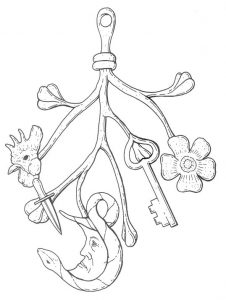
In a very long article by R. T. Gunther, which appeared in the Folklore Quarterly Review (1905) we find a large array of cimaruta designs. Although the article seems to be a rebuttal against Frederick Elworthy’s research on the cimaruta there is still a lot of useful material to be found.
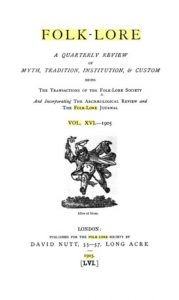
Most noteworthy is Gunther’s acknowledgement of the cimaruta’s pagan roots, which are evident in his associating various symbols on the cimaruta with the goddess Artemis/Diana. He also suggests that the cimaruta design may have evolved from ancient tree worship. Gunther states that he does not believe the cimaruta to have been of ancient Roman origins, and he goes on to state that the cimaruta is not a single charm, but is instead a composite charm consisting of individual charms. All of these, says Gunther, appear individually as magical charms and are of considerable antiquity. Here are some drawings from Gunther’s article:

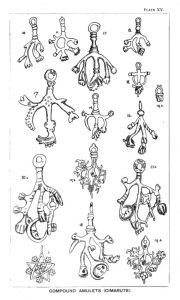
One of the most common designs of the 19th century appears below and is the one that most people copy as an example. Pictures and drawings of this common folk magic design have appeared in many publications. Note the inclusion of the “sacred heart” symbol on the bottom, which is a sure sign of a newer cimaruta. This design appears circa 1888. Here we find one of the first non-witchcraft designs and uses of the cimaruta charm (as it appears in Italian folk magic versus witchcraft) :
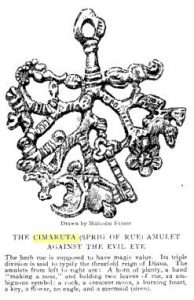
Many folk magic charms, such as the one above, are designed to be anti-witchcraft in nature and function. They frequently incorporate authentic witch symbolism but also include a Catholic symbol, prayer, or religious item. This is done in a belief that the Christian element conquers the witchcraft element, thus reversing the power. This approach created a great deal of confusion for folklorists and historians who research folk magic symbols and practices (leading most to erroneous conclusions about the nature and purpose of such charms as the cimaruta). One example appears in the custom of placing a cimaruta on the crib of a newborn (or upon the newborn) in a belief that it protects the infant from the evil eye and witchcraft. The actual custom is derived from the ancient practice of Roman women who gave offerings to the goddess Diana for an easy childbirth. In this light we see that the cimaruta charm was intended as a tribute to Diana following the infant’s birth, and to evoke her blessings upon the baby. Unfortunately such old beliefs and practices were covered over by the Church and its agents, and became lost to the common person. In the case of the cimaruta, the Church’s reversal of the infant custom (making it an anti-witchcraft charm) caused scholars to misunderstand the cimaruta. This is true of many other charms and customs distorted by the Church and adopted by the common people (thus becoming a folk tradition).
The following cimaruta designs are included in Gunther’s article. Note the variety of symbols that appear on the cimaruta charms. Some are simple designs and others more elaborate. Gunther notes that the most common symbols on the charm are the sprig of rue, hand, moon, key, flower, horn or fish, and cock or eagle. He states that newer designs include the heart, cherub, and serpent. He is however, mistaken about the serpent as it does appear wrapped around the moon. Gunther dismisses this by saying that people probably mistook an ornate ridge around the moon as a serpent figure, and from there on included the snake with the moon. But this seems like a personal opinion as he does not offer any supporting evidence to back up his claim. When we add the fact that Proserpina is traditionally symbolized by the serpent, appears within the ancient triformis grouping (Hecate-Diana-Proserpina), and that the three branches of the cimaruta represent the triformis goddess, Gunther’s position is without credible defense.
Gunther refers to the following cimaruta designs as aberrant and degenerate forms of the design, which he believes were added either intentionally or because of copying errors (meaning that the artists were unsure of what the symbol was actually meant to depict).
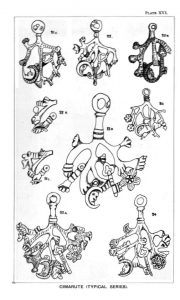
Despite Gunther’s narrow views and personal skepticism (regarding the history and symbolism of the cimaruta) we do owe him gratitude for recording the depictions of the cimaruta charm in his article. For a more realistic understanding of the cimaruta we can turn to Frederick Elworthy, a contemporary folklorist of Gunther’s era. In his book The Evil Eye, Elworthy suggests that the cimaruta evolved from rue amulets that were used by the ancient Etruscans, and he calls the rue charm one of the oldest existing amulets. The following is an except from Elworthy’s book:
“In all the complete specimens here produced, it will be seen that the Cimaruta has three main branches; and considering the material of which these charms are always made, in connection with the other symbols on this complex object, we can come to no other conclusion than that the three branches are typical of Diana Triformis or her prototypes. Epithets are given to her denoting that she is the giver of light and life, benefits also attributed to Proserpine, and these ‘ make it seem that she (Proserpine) was also thought to be concerned for women in labour, which cannot appear strange if we consider her as the same goddess with Diana, who being three in different capacities, as conversant in heaven, earth, and hell, has three distinct names…” – page 348
Elworthy describes some of the symbols on the cimaruta and their meanings. Pictured below is a cimaruta sample from his book:
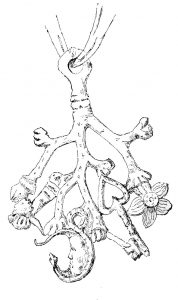
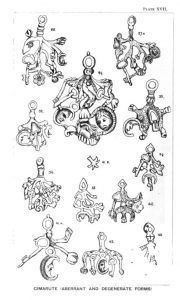
Elworthy states that the key traditionally forms a heart symbol on the handle. He associates the key with Diana and the goddess Jana, the gatekeeper (consort of Janus). Elworthy also notes that the key is a traditional symbol of Hecate-Proserpine. He goes on to mention that in Neapolitan dialect the word janara means a witch (in Italian, strega).
Elworthy mentions the rooster head on the traditional cimaruta, and he gives its meaning as vigilance. The rooster, says Elworthy, is the “watchful guardian” (and the author notes this symbolism in connection with the custom of placing the cimaruta charm with an infant).
The dagger, says Elworthy, represents the “dart of Diana Venetrix ” and the fish symbolizes the connection to Diana-Proserpina (symbolized in ancient art by the dolphin). Elworthy identifies the flower on the cimaruta charm as a “lotus” and he associates it with Isis and Diana. However, in this one area Elworthy is incorrect. The flower is actually a vervain blossom, which in Italian lore is connected to fairy lore (and folklorist Charles Leland refers to Diana as the queen of the fairies).
In closing here is an excerpt from Elworthy. Noteworthy is his mention of the survival of the worship of Diana in Italy into modern times :
“Of all the many charms combined in the Cimaruta we find on close study that there is scarcely one which may not directly or indirectly be considered as connected with Diana, the goddess of infants, worshipped today by Neapolitans as zealously as ever she was in old times by the men of Ephesus and Rome; the only change is in her name. Many a Demetrius, who still makes her silver shrines, flourishes near the Piazza Margherrita, though nowadays he knows her only as La Madonna; she is, however, his goddess, his ‘regina del Cielo, della terra, del parto, ed anche del Inferna’ – page 335

